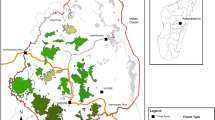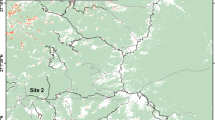Abstract
Understanding wildlife movements and habitat selection are critical to drafting conservation and management plans. We studied a population of eastern Hermann’s tortoise (Testudo hermanni boettgeri) in a traditionally managed rural landscape in Romania, near the northern edge of the species geographic distribution. We used telemetry to radio-track 24 individuals between 2005 and 2008 and performed a Euclidian distance-based habitat selection analysis to investigate habitats preferred by tortoises at both landscapes (second-order order selection) and individual (third-order selection) home range scales. The home range size for tortoises in our study area was 3.79 ± 0.62 ha and did not differ by gender or season (pre- and post-nesting seasons). Their movement ecology was characterized by short-distance movements (daily mean = 31.18 ± 1.59 m), apparently unaffected by habitat type. In contrast to other studies, movements of males and females were of similar magnitude. At the landscape (population home range) scale, grasslands and shrubs were preferred, but tortoises also showed affinity to forest edges. At the individual home range scale, tortoises selected grassland and shrub habitats, avoided forests, and used forest edges randomly. Creeks were avoided at both spatial scales. Our results suggest that tortoise home ranges contain well-defined associations of habitats despite a higher selection for grasslands. As such, avoiding land conversion to other uses and maintaining habitat heterogeneity through traditional practices (e.g., manual mowing of grasslands, livestock grazing) are critical for the persistence of tortoise populations.



Similar content being viewed by others
References
2006/105/EC (2006) Council Directive 2006/105/EC of 20 November 2006 adapting Directives 73/239/EEC, 74/557/EEC and 2002/83/EC in the field of environment, by reason of the accession of Bulgaria and Romania. Official Journal L 363, 20/12/2006
92/43/EEC (1992) Council Directive 92/43/EEC of 21 May 1992 on the conservation of natural habitats and of wild fauna and flora, vol 92/43/EEC. Official Journal, L 206, 22.7.1992
Aebischer NJ, Robertson PA, Kenward RE (1993) Compositional analysis of habitat use from animal radio-tracking data. Ecology 74(5):1313–1325
Anadon JD, Gimenez A, Martinez M, Palazon JA, Esteve MA (2007) Assessing changes in habitat quality due to land use changes in the spur-thighed tortoise Testudo graeca using hierarchical predictive habitat models. Divers Distrib 13(3):324–331
Bertolero A, Cheylan M, Hailey A, Livoreil B, Willemsem RE (2011) Testudo hermanni (Gmelin 1789)—Hermann’s tortoise. In: Rhodin AGJ, Pritchard PCH, van Dick PP, Saumure RA, Buhlmann KA, Iverson JB, Mittermeier RA (eds) Conservation biology of freshwater turtles and tortoises: a compilation project of the IUCN/SSC Tortoise and Freshwater Turtle Specialist Group. Chelonian Research Monographs, 5, 059.1–059.20
Blouin-Demers G, Weatherhead PJ (2001) Habitat use by black rat snakes (Elaphe obsoleta obsoleta) in fragmented forests. Ecology 82:2882–2896
Blouin-Demers G, Weatherhead PJ (2002) Habitat-specific behavioural thermoregulation by black rat snakes (Elaphe o. obsoleta). Oikos 97:59–68
Börger L, Dalziel BD, Fryxell JM (2008) Are there general mechanisms of animal home range behaviour? A review and prospects for future research. Ecol Lett 11(6):637–650
Calzolai R, Chelazzi G (1991) Habitat use in a Central Italy population of Testudo hermanni Gmelin (Reptilia-Testudinidae). Ethol Ecol Evol 3(2):153–166
Chen J, Saunders SC, Crow TR, Naiman RJ, Brosofske KD, Mroz GD, Brookshire BL, Franklin JF (1999) Microclimate in forest ecosystem and landscape ecology. Bioscience 49(4):288–297
Cheylan M (2001) Testudo hermanni Gmelin, 1789 – Griechische Landschildkröte. In: Fritz U (ed) Handbuch der Reptilien und Amphibien Europas. Band 3/IIIA: Schildkröten I. Aula-Verlag, Wiebelsheim, pp 179–289
Conner LM, Plowman BW (2001) Using Euclidean distances to assess non-random habitat use. In: Millspaugh JJ, Marzluff JM (eds) Radio tracking and animal populations. Academic, San Diego, pp 275–289
Conner LM, Smith MD, Burger LW (2003) A comparison of distance-based and classification-based analyses of habitat use. Ecology 84(2):526–531
Conner LM, Smith MD, Burger LW (2005) A comparison of distance-based and classification-based analyses of habitat use: reply. Ecology 86(11):3125–3129
Cox NA, Temple HJ (2009) European red list of reptiles. Office for Official Publications of the European Communities, Luxembourg
Cruce M, Răducan L (1975) Cycle d’activité chez la tortue terrestre (Testudo hermanni hermanni Gmel.). Rev Roum Biol (Biol Anim) 20:285–289
Cruce M, Raducan L (1976) Reproducerea la broasca ţestoasă de uscat (Testudo hermanni hermanni G.). Studii şi cercetări de Biologie. Seria Biologie Animală 28:175–180
Del Vecchio S, Burke RL, Rugiero L, Capula M, Luiselli L (2011a) Seasonal changes in the diet of Testudo hermanni hermanni in Central Italy. Herpetologica 67(3):236–249
Del Vecchio S, Burke RL, Rugiero L, Capula M, Luiselli L (2011b) The turtle is in the details: microhabitat choice by Testudo hermanni is based on microscale plant distribution. Anim Biol 61(3):249–261
Diaz-Paniagua C, Keller C, Andreu AC (1995) Annual variation of activity and daily distances moved in adult spur-thighed tortoises, Testudo graeca, in Southwestern Spain. Herpetologica 51(2):225–233
Downs JA, Horner MW (2008) Effects of point pattern shape on home-range estimates. J Wildlife Manage 72(8):1813–1818
Edge CB, Steinberg BD, Brooks RJ, Litzgus JD (2010) Habitat selection by Blanding's turtles (Emydoidea blandingii) in a relatively pristine landscape. Ecoscience 17(1):90–99
Fernández-Chacón A, Bertolero A, Amengual AD, Tavecchia G, Homar V, Oro D (2011) Spatial heterogeneity in the effects of climate change on the population dynamics of a Mediterranean tortoise. Global Change Biol: 17(10):3075–3088
Hailey A (1989) How far do animals move? Routine movements in a tortoise. Can J Zool 67(1):208–215
Huot-Daubremont C, Grenot C (1997) Activity rhythm of Hermann tortoise (Testudo hermanni hermanni) in semi-free state in the Massif des Maures (Var). La Terre et la Vie-Revue d’Ecologie 52(4):331–344
Ioja CI, Patroescu M, Rozylowicz L, Popescu VD, Verghelet M, Zotta ML, Felciuc M (2010) The efficacy of Romania's protected areas network in conserving biodiversity. Biol Conserv 143(11):2468–2476
Iosif R (2012) Evaluating the potential impacts of transportation infrastructure on Hermann’s tortoise (Testudo hemanni boettgeri) populations in Romania. MS thesis, University of Bucharest, Romania
Johnson DH (1980) The comparison of usage and availability measurements for evaluating resource preference. Ecology 61:65–71
Kernohan BJ, Gitzen RA, Millspaugh JJ (2001) Analysis of animal space use and movements. In: Millspaugh JJ, Marzluff JM (eds) Radio tracking and animal populations. Academic, San Diego, pp 125–166
Longepierre S, Hailey A, Grenot C (2001) Home range area in the tortoise Testudo hermanni in relation to habitat complexity: implications for conservation of biodiversity. Biodivers Conserv 10(7):1131–1140
Loy A, Cianfrani C (2010) The ecology of Eurotestudo h. hermanni in a mesic area of southern Italy: first evidence of sperm storage. Ethol Ecol Evol 22(1):1–16
Luiselli L, Rugiero L (2006) Ecological modelling of habitat use and the annual activity patterns in an urban population of the tortoise, Testudo hermanni. Ital J Zool 73(3):219–225
Luiselli L, Rugiero L, Celleti S, Papi R, Gracceva G, Stacchiotti M, Mancini F, Berretta G, Berretta L, Bombara G, Fiaschetti R, Lucioli E, Trionfetti MG, Ungaro A (2009) Autumnal home range in radio-tracked tortoises (Testudo hermanni) from a semi-arid mediterranean environment. La Terre et la Vie-Revue d’Ecologie 64(1):73–78
Manly BFJ (1997) Randomization, bootstrap and Monte Carlo methods in biology, 2nd edn. Texts in statistical science. Chapman and Hall, London
Manly BFJ (2002) Resource selection by animals: statistical design and analysis for field studies, 2nd edn. Kluwer Academic, Dordrecht
Matacă ŞS (2002) Vegetaţia forestieră şi arbustivă din Parcul Natural Porţile de Fier. Drobeta XI-XII:296–336
Matacă ŞS (2005) Parcul Natural Porţile de Fier. Floră, vegetaţie şi protecţia naturii. Editura Universitaria, Craiova
Mazzotti S, Pisapia A, Fasola M (2002) Activity and home range of Testudo hermanni in Northern Italy. Amphibia-Reptilia 23(3):305–312
Pătroescu M, Rozylowicz L (2000) Natural transborder parks: the direction of biodiversity preservation in Romania. In: Crabbé P, Holland A, Ryszkowski L, Westra L (eds) Implementing ecological integrity: restoring regional and global environmental and human health, vol 1. NATO Science series: IV: earth and environmental sciences, vol IV: earth and environmental series. Kluwer Academic, Dordrecht
Phillips A (2002) Management guidelines for IUCN Category V Protected Areas Protected Landscapes/Seascapes. World Commission on Protected Areas (WCPA), Best Practice Protected Area Guidelines Series No. 9. IUCN Gland, Switzerland and Cambridge, UK
Pough FH (2004) Herpetology, 3rd edn. Prentice Hall, Upper Saddle River
Row JR, Blouin-Demers G (2006) Kernels are not accurate estimators of home-range size for herpetofauna. Copeia 2006(4):797–802
Rozylowicz L (2008) Metode de analiză a distribuţiei areal-geografice a ţestoasei lui Hermann (Testudo hermanni Gmelin, 1789) în România. Studiu de caz: Parcul Natural Porţile de Fier. Editura Universităţii din Bucureşti, Bucureşti
Rozylowicz L, Dobre M (2010) Assessing the threatened status of Testudo hermanni boettgeri Mojsisovics, 1889 (Reptilia: Testudines: Testudinidae) population from Romania. North-West J Zool 6(2):190–202
Willemsen RE (1991) Differences in thermoregulation between Testudo hermanni and Testudo marginata and their ecological significance. Herpetol J 1(12):559–567
Zar JH (2010) Biostatistical analysis, 5th edn. Pearson Prentice Hall, Upper Saddle River
Acknowledgments
This work was supported by a grant of the Romanian National Authority for Scientific Research, CNCS—UEFISCDI, project number PN-II-RU-TE-2011-3-0183. The study has been carried out with the logistic support of the Iron Gates Eşelniţa Field Center, Center for Environmental Research and Impact Studies. We are grateful to our colleagues who helped us with radio-tracking and study design: Maria Pătroescu, Mariana Dobre, Steluţa Manolache, Vasile Bagrinovschi, Georgeta Bagrinovschi, Iulian Niculae, Cristian Tetelea, Gabriel Vânău, and Mihai Răzvan Niţă. We would like to thank two anonymous reviewers for their valuable comments.
Author information
Authors and Affiliations
Corresponding author
Additional information
Communicated by C. Gortázar
Rights and permissions
About this article
Cite this article
Rozylowicz, L., Popescu, V.D. Habitat selection and movement ecology of eastern Hermann’s tortoises in a rural Romanian landscape. Eur J Wildl Res 59, 47–55 (2013). https://doi.org/10.1007/s10344-012-0646-y
Received:
Revised:
Accepted:
Published:
Issue Date:
DOI: https://doi.org/10.1007/s10344-012-0646-y




